Pore Structure Characteristics and Main Control Factors of Sandstone in the Jurassic Zhiluo Formation in the Northern Ordos Basin
Abstract
:1. Introduction
2. Geological Setting
3. Samples and Methods
4. Results
4.1. Petrology Characteristics
4.2. Pore Types and Characteristics
4.3. Throat Types and Characteristics
4.4. Microcrack Characteristics
4.5. Pore Structure and Fractal Characteristics
4.6. Pore Structure Types
5. Discussion
5.1. Sedimentation and Pore Structure
5.2. Diagenesis and Pore Structure
5.3. Tectonic Action and Pore Structure
6. Conclusions
- The primary pores in the study area include primary intergranular pores, residual intergranular pores, and interstitial micropores. The secondary pores mainly include intergranular pores, feldspar dissolution pores, and rock debris dissolution pores. The common throat types include variable cross-sections, sheet-like, curved sheet-like, and bundle-shaped throats.
- The pore structure of the Zhiluo Formation sandstone in the research area is complex, and its permeability is influenced by the throat characteristics. Based on the pore structure characteristics, we selected characteristic parameters with good correlations and used a combination of macro and micro methods to classify the pore structure types of the Zhiluo Formation sandstone into four types.
- The main factors affecting the pore structure characteristics of the Zhiluo Formation sandstones in the study area mainly include sedimentation and diagenesis, and the tectonic activity effect is minimal. Compaction and cementation are the main factors that have damaged the pore structure of the sandstone in the study area, and later dissolution has played a certain role in improving the pore structure. Comparatively speaking, section 1 of the Zhiluo Formation has been greatly affected by diagenesis, and section 2 has been greatly affected by sedimentation.
Author Contributions
Funding
Data Availability Statement
Conflicts of Interest
References
- Liao, J.; Xi, A.; Liang, S.; Zhou, X.; Li, Z.; Di, J.; Zhang, W.; Rong, W.; Yu, P. Genetic mechanisms of deep-water massive sandstones in continental lake basins and their significance in micro–nano reservoir storage systems: A case study of the Yanchang formation in the Ordos Basin. Nanotechnol. Rev. 2020, 9, 489–503. [Google Scholar] [CrossRef]
- Yang, H.; Li, Z.; Liu, X. Characteristics and resource prospects of tight oil and shale oil in Ordos Basin. Acta Pet. Sin. 2013, 34, 1–11. [Google Scholar]
- Li, X.; Liu, H.; Pan, S.; Chen, Q.; Rong, W.; Xu, W.; Wang, H.; Huang, J.; Jing, W. Subaqueous sandy mass-transport deposits in lacustrine facies of the Upper Triassic Yanchang Formation, Ordos Basin, Central China. Mar. Pet. Geol. 2018, 98, 66–77. [Google Scholar] [CrossRef]
- Wang, Y. The relationship between oilfield development and pore structure of reservoir rocks. J. Geosci. Coll. Chengdu 1982, 22, 97–113. [Google Scholar]
- Luo, Z.; Wang, Y. Reservoir pore structure, wettability, and oilfield recovery rate. J. Geosci. Coll. Chengdu 1980, 10, 1–16. [Google Scholar]
- Wang, Y.; Zhao, X.; Tang, C.; Zhang, X.; Ma, C.; Yi, X.; Tan, F.; Zhao, D.; Li, J.; Jing, Y. Study on Microscopic Pore Structure Classification for EOR of Low Permeability Conglomerate Reservoirs in Mahu Sag. Energies 2023, 16, 626. [Google Scholar] [CrossRef]
- Zhang, F.; Jiang, Z.; Sun, W.; Li, Y.; Zhang, X.; Zhu, L.; Wen, M. A multiscale comprehensive study on pore structure of tight sandstone reservoir realized by nuclear magnetic resonance, high pressure mercury injection and constant-rate mercury injection penetration test. Mar. Pet. Geol. 2019, 109, 208–222. [Google Scholar] [CrossRef]
- Yin, D.; Wang, D.; Zhou, Y.; Zhang, C. Pore Structure Characteristics of Ultra-Low Permeability Reservoirs. Nat. Resour. Res. 2021, 30, 451–462. [Google Scholar] [CrossRef]
- Mahmud, W.; Yin, X.; Ermila, M. Evaluation of a non-interactive bundle-of-tubes model for calculation of unsteady-state relative permeabilities with laboratory measurements. J. Porous Media 2020, 23, 1167–1186. [Google Scholar] [CrossRef]
- Rezaee, R.; Saeedi, A.; Clennell, B. Tight gas sands permeability estimation from mercury injection capillary pressure and nuclear magnetic resonance data. J. Pet. Sci. Eng. 2012, 88, 92–99. [Google Scholar] [CrossRef]
- Zheng, S.; Yao, Y.; Liu, Y. Characterizations of full-scale pore size distribution, porosity and permeability of coals: A novel methodology by nuclear magnetic resonance and fractal analysis theory. Int. J. Coal Geol. 2018, 196, 148–158. [Google Scholar] [CrossRef]
- Wang, W.; Ye, Y.; Guo, H. Experimental studies of NMR properties of continental sedimentary rocks. Chin. J. Magn. Reson. 2001, 19, 113–121. [Google Scholar]
- Lai, J.; Pang, X.; Li, Y. Typical misinterpretations and scientific concepts in well-logging geologic studies. Nat. Gas Ind. 2023, 10, 198–211. [Google Scholar] [CrossRef]
- Elliot, T.; Heck, R. A comparison of optical and X-ray CT technique for void analysis in soil thin section. Geoderma 2007, 141, 60–70. [Google Scholar] [CrossRef]
- Yoshito, N.; Susumu, K. Mathematica programs for the analysis of three dimensional pore connectivity and anisotropic tortuosity of porous rocks using X-ray computed tomography image data. J. Nucl. Sci. Technol. 2007, 44, 1233–1247. [Google Scholar]
- Karayigit, A.; Oskay, R.; Bulut, Y.; Mastalerz, M. Meso- and microporosity characteristics of Miocene lignite and subbituminous coals in the Knk coalfield (Soma Basin, W. Turkey). Int. J. Coal Geol. 2020, 232, 103624. [Google Scholar] [CrossRef]
- Zou, J.; Fan, C.; Jiang, Y.; Liu, X.; Zhou, W.; Xu, H.; Huang, L. A preliminary study on assessing the Brunauer-Emmett-Teller analysis for disordered carbonaceous materials. Microporous Mesoporous Mater. 2021, 327, 111411. [Google Scholar] [CrossRef]
- Quiblier, J. A new three-dimensional modeling technique for studying porous media. J. Colloid Interface Sci. 1984, 98, 84–102. [Google Scholar] [CrossRef]
- Lai, J.; Wang, G.; Fan, Z.; Zhou, Z.; Jing, C.; Wang, S. Fractal analysis of tight shaly sandstones using nuclear magnetic resonance measurements. AAPG Bull. 2018, 102, 175–193. [Google Scholar] [CrossRef]
- Hazlett, R. Statistical characterization and stochastic 3D modeling of pore networksin relation to fluid flow. Math. Geol. 1997, 29, 801–822. [Google Scholar] [CrossRef]
- Yao, J.; Zhao, X.; Yi, Y.; Tao, J. The current situation and prospect on digital core technology. Pet. Geol. Recovery Effic. 2005, 12, 52–54. [Google Scholar]
- Zhao, X.; Yao, J.; Tao, J.; Yi, Y. A method of constructing digital core by simulated annealing algorithm. Appl. Math. A J. Chin. Univ. (Ser. A) 2007, 22, 127–133. [Google Scholar]
- Zhu, Y.; Tao, G.; Fang, W.; Xu, X. Lattice Boltzmann Simulation of Permeability in 3D Porous Medium. Well Logging Technol. 2008, 32, 25–28. [Google Scholar]
- Zhu, H. Pore Structure Characterization of Low Permeability Sandstone Reservoir and Application. Ph.D. Thesis, Southwest Petroleum University, Chengdu, China, 2014. [Google Scholar]
- Qiao, J.; Zeng, J.; Chen, D.; Cai, J.; Jiang, S.; Xiao, E.; Zhang, Y.; Feng, X.; Feng, S. Permeability estimation of tight sandstone from pore structure characterization. Mar. Pet. Geol. 2022, 135, 105382. [Google Scholar] [CrossRef]
- Hu, Q.; Ewing, R.P.; Dultz, S. Low pore connectivity in natural rock. J. Contam. Hydrol. 2012, 133, 76–83. [Google Scholar] [CrossRef]
- Huang, H.; Chen, L.; Sun, W.; Xiong, F.; Ji, W.; Jia, J.; Tang, X.; Zhang, S.; Gao, J.; Luo, N. Pore-throat structure and fractal characteristics of Shihezi Formation tight gas sandstone in the Ordos Basin, China. Fractals 2018, 26, 1840005. [Google Scholar] [CrossRef]
- Clarkson, C.; Solano, N.; Bustin, R.; Bustin, A.; Chalmers, G.; He, L.; Melnichenko, Y.; Radlinski, A.; Blach, T. Pore structure characterization of North American shale gas reservoirs using USANS/SANS, gas adsorption, and mercury intrusion. Fuel 2013, 103, 606–616. [Google Scholar] [CrossRef]
- Wang, R.; Sang, S.; Zhu, D.; Liu, S.; Yu, K. Pore characteristics and controlling factors of the Lower Cambrian Hetang Formation shale in Northeast Jiangxi, China. Energy Explor. Exploit. 2018, 36, 43–65. [Google Scholar] [CrossRef]
- Deng, Y.; Chen, S.; Pu, X.; Yan, J. Characteristics and Controlling Factors of Shale Oil Reservoir Spaces in the Bohai Bay Basin. Acta Geol. Sin. 2019, 94, 253–268. [Google Scholar] [CrossRef]
- Wang, J.; Han, D.; Deng, Y.; Lin, W.; Su, A.; Wang, C.; Zhang, J.; Zhang, J. Differential Characteristics and the Main Controlling Factors of Shale Oil Sweet Spot Reservoirs in Lucaogou Formation, Jimsar Sag, Junggar Basin. Geofluids 2022, 13, 6936161. [Google Scholar] [CrossRef]
- Chen, D.; Zhang, Y.; Liu, Y.; Zhong, D.; Meng, H. Characteristics and Controlling Factors of Micro- and Nano-Scale Reservoirs in Continental Shale Sequence of Western Sichuan Depression, China. J. Nanosci. Nanotechnol. 2017, 17, 6159–6168. [Google Scholar]
- Wu, H.; Du, Z.; Ji, Y.; Cao, H.; Meng, L.; Liu, H.; Ma, J. Diagenetic controls on pore structure variations in fan deltaic sandstones of the Eocene Shahejie Formation, Bohai Bay Basin, China: Implications for reservoir quality and oiliness heterogeneities. Geol. J. 2023, 58, 3191–3219. [Google Scholar] [CrossRef]
- Wang, J.; Jiang, F.; Hu, Q.; Zhang, C.; Yang, X.; Mo, W.; Wang, X.; Qi, Z. A quantitative model and controlling factors of secondary pore development for tight sandstone reservoirs in the carboniferous Benxi Formation, Ordos Basin, China. Mar. Pet. Geol. 2023, 148, 106034. [Google Scholar] [CrossRef]
- Guo, F.; Peng, X.; Ma, X.; Wang, H. Main controlling factors and oil-bearing potential characteristics of a tight sandstone reservoir: A case study of southwest Ordos Basin. Energy Explor. Exploit. 2023, 41, 1288–1307. [Google Scholar] [CrossRef]
- Bai, B.; Zhu, R.; Wu, S.; Yang, W.; Gelb, J.; Gu, A.; Zhang, X.; Su, L. Multi-scale method of Nano(Micro)-CT study on microscopic pore structure of tight sandstone of Yanchang Formation, Ordos Basin. Pet. Explor. Dev. 2013, 40, 354–358. [Google Scholar] [CrossRef]
- Lu, X.; Wang, J.; Ge, L.; Hu, F.; Li, C.; Li, X.; Yu, J.; Xu, H.; Lu, S.; Xue, Q. Pore-scale characterization of tight sandstone in Yanchang Formation Ordos Basin China using micro-CT and SEM imaging from nm- to cm-scale. Fuel 2017, 209, 254–264. [Google Scholar] [CrossRef]
- Yang, J.; Leng, F.; Yu, H.; Zhao, Y. Micro-pore structure characteristics of the Chang 6 member sandstone reservoir in Huangjiang oilfield Ordos Basin China. Fresenius Environ. Bull. 2021, 30, 5377–5384. [Google Scholar]
- Wu, K.; Cen, D.; Zhang, W.; Yang, H.; Wu, H.; Cheng, X.; Qu, Y.; He, M. Movable Fluid Distribution Characteristics and Microscopic Mechanism of Tight Reservoir in Yanchang Formation, Ordos Basin. Front. Earth Sci. 2022, 10, 840875. [Google Scholar] [CrossRef]
- Lai, J.; Wang, G.; Cen, M.; Wang, S.; Chai, Y.; Cai, C.; Zhang, Y.; Li, J. Pore structures evaluation of low permeability clastic reservoirs based on petrophysical facies: A case study on Chang 8 reservoir in the Jiyuan region, Ordos Basin. Pet. Explor. Dev. 2013, 40, 606–614. [Google Scholar] [CrossRef]
- Li, G.; Liu, C.; Zhou, Y.; Wu, H.; Awan, R.; Shi, F.; Wu, Y.; Zang, Q.; Wu, Y. Controlling effects of pore-throat structure and fractal characteristics on the physical properties of ultra-low permeability sandstone reservoirs: A case study of the sixth member of the Yanchang Formation in the Xiaojiahe area, Ordos Basin. Geol. J. 2023, 58, 1945–1964. [Google Scholar] [CrossRef]
- Ren, D.; Sun, W.; Huang, H.; Nan, J.; Chen, B. Determination of microscopic waterflooding characteristics and influence factors in ultra-low permeability sandstone reservoir. J. Cent. South Univ. 2017, 24, 2134–2144. [Google Scholar] [CrossRef]
- Liao, J.; Hong, L.; Li, Z.; Tan, K.; Zhao, L.; Yang, J.; Yu, P. Characterization of ultra-low permeability tight sandstone reservoir properties and criteria for hydrocarbon accumulation in Chang 6 member, Huaqing area, Ordos basin. Front. Earth Sci. 2022, 10, 1013776. [Google Scholar] [CrossRef]
- Zhang, Y.; Chen, Y.; Zhang, Q.; Meng, X. Tectonic sequences of Triassic strata in the southern Ordos Basin, China. Stratigraphy 2017, 13, 205–219. [Google Scholar] [CrossRef]
- Zhao, J.; Liu, C.; Zhao, J.; Wang, X. Sedimentary facies and its evolution of Jurassic Zhiluo Formation in Ordos Basin. J. Northwest Univ. (Nat. Sci. Ed.) 2008, 38, 480–486. [Google Scholar]
- Cui, L.; Peng, N.; Liu, Y.; Qiao, D.; Liu, Y. Sedimentary Filling Evolution under Paleoclimate Transition—A Case Study from the Middle Jurassic Zhiluo Formation, Ordos Basin. Minerals 2023, 13, 314. [Google Scholar] [CrossRef]
- Cai, Y.; Han, M.; Zhang, C.; Yi, C.; Li, X.; Zhang, Y.; Wang, G.; Li, H. Geological and Geochemical Characteristics of the Zhiluo Formation in the Bayinqinggeli Uranium Deposit, Northern Ordos Basin: Significance for Uranium Mineralization. Acta Geol. Sin. 2022, 95, 2075–2086. [Google Scholar] [CrossRef]
- Cai, Y.; Ouyang, F.; Luo, X.; Zhang, Z.; Wen, M.; Luo, X.; Tang, R. Geochemical Characteristics and Constraints on Provenance, Tectonic Setting, and Paleoweathering of Middle Jurassic Zhiluo Formation Sandstones in the Northwest Ordos Basin, North-Central China. Minerals 2022, 12, 603. [Google Scholar] [CrossRef]
- Folk, R. Petrology of Sedimentary Rocks; Hemphill Publishing Company: Austin, TX, USA, 1968; p. 184. [Google Scholar]
- Lu, S.; Li, J.; Zhang, P.; Xue, H.; Wang, G.; Zhang, J.; Liu, H.; Li, Z. Classification of microscopic pore-throats and the grading evaluation on shale oil reservoirs. Pet. Explor. Dev. 2018, 45, 452–460. [Google Scholar] [CrossRef]
- Lng, K.; Zhang, Z.; Ring, U.; Faulkner, D.; Gamage, R. Microcracks development and porosity evolution in sandstone, Sichuan basin, China: An experimental approach. Bull. Eng. Geol. Environ. 2021, 80, 7717–7729. [Google Scholar] [CrossRef]
- Yang, F. Microscopic Pore Structure Using Fractal Simulation A Case Study of Shengtuo Oilfield; University of Petroleum: Beijing, China, 2011. [Google Scholar]
- Hecht, A. Appolonian packing and fractal shape of grains improving geo mechanical properties in engineering geology. Pure Appl. Geophys. 2000, 157, 487–504. [Google Scholar] [CrossRef]
- Krohn, C. Sandstone fractal and euclidean pore volume distributions. J. Geophys. Res. 1988, 93, 3297–3305. [Google Scholar] [CrossRef]
- Amir, M.; Nahla, A. Controls of pore throat radius distribution on permeability. J. Pet. Sci. Eng. 2017, 157, 941–950. [Google Scholar]
- Morad, S.; Al-Ramadan, K.; Ketzer, J.; De Ros, L. The impact of diagenesis on the heterogeneity of sandstone reservoirs: A review of the role of depositional facies and sequence stratigraphy. AAPG Bull. 2010, 94, 1267–1309. [Google Scholar] [CrossRef]
- Lai, J.; Wang, G.; Wang, Z.; Chen, J.; Pang, X.; Wang, S.; Zhou, Z.; He, Z.; Qin, Z.; Fan, X. A review on pore structure characterization in tight sandstones. Earth-Sci. Rev. 2018, 177, 436–457. [Google Scholar] [CrossRef]
- Ma, B.; Chen, S.; Yan, W.; Lin, C.; Zhang, H.; Sun, Z.; Zheng, J.; Wang, Y.; Wu, S.; Wang, J. Pore structure evaluation of low permeability clastic reservoirs based on sedimentation diagenesis: A case study of the Chang 8 reservoirs in the Zhenbei region, Ordos Basin. J. Pet. Sci. Eng. 2021, 196, 107841. [Google Scholar]
- Wang, J.; Fu, Y.; Yan, Z.; Fu, J.; Xie, J.; Li, K.; Zhao, Y. Influence of sedimentation and diagenesis on reservoir physical properties: A case study of the Funing Formation, Subei Basin, eastern China. Earth Sci. 2021, 15, 892–908. [Google Scholar] [CrossRef]
- Wang, Y.; Wu, Y.; Ge, Q.; Pu, Z.; Lu, J.; Zhang, Y.; Xie, X. A Sedimentary Facies-Based Method to Control Water Hazards in the Roof of Deep Jurassic Coals. Mine Water Environ. 2023, 7, 1. [Google Scholar] [CrossRef]
- Zhao, J.; Liu, C.; Huang, L.; Zhang, D.; Wang, D.; Wang, D. Paleogeography reconstruction of a multi-stage modified intra-cratonic basin-a case study from the Jurassic Ordos Basin, Western North China Craton. J. Asian Earth Sci. 2020, 190, 104191. [Google Scholar] [CrossRef]
- Zhao, J.; Shen, J.; Qin, Y.; Wang, J.; Zhao, J.; Li, C. Coal Petrology Effect on Nanopore Structure of Lignite: Case Study of No. 5 Coal Seam, Shengli Coalfield, Erlian Basin, China. Nat. Resour. Res. 2021, 30, 681–695. [Google Scholar] [CrossRef]
- Xi, Z.; Tang, S.; Lash, G.G.; Ye, Y.; Lin, D.; Zhang, B. Depositional controlling factors on pore distribution and structure in the lower Silurian longmaxi shales: Insight from geochemistry and petrology. Mar. Pet. Geol. 2021, 130, 105114. [Google Scholar] [CrossRef]
- Beard, D.C.; Weyl, P.K. Influence of texture on porosity and permeability of unconsolidated sand. AAPG Bull. 1973, 57, 349–369. [Google Scholar]
- Yin, Y.; Guo, X.; Li, Y. Experimental study on pore structures and diagenesis of the Upper Triassic Yanchang Formation in Ordos Basin China. Fresenius Environ. Bull. 2022, 31, 6561–6568. [Google Scholar]
- Fu, G.; Qin, X.; Miao, Q. Division of diagenesis reservoir facies and its control: Case study of Chang3 reservoir in Yangchang Formation of Fuxian exploration area in northern Shaanxi. Min. Sci. Technol. 2009, 19, 537–543. [Google Scholar] [CrossRef]
- Cao, X.; Zhong, D.; Liu, J.; Sun, H.; Song, Z.; Cao, T.; Wang, F.; Gong, S. Coupling between Diagenetic Environment and Porosity Evolution-A Quantitative Study of the Zhuhai Formation in the Huizhou Sag, Pearl River Mouth Basin, South China Sea. Minerals 2020, 10, 170. [Google Scholar] [CrossRef]
- Yang, R.; Wang, F.; Yun, N.; Zeng, H.; Han, Y.; Hu, X.; Diao, N. Pore structure characteristics and permeability stress sensitivity of Jurassic continental shale of Dongyuemiao member of Ziliujing Formation, Fuxing Area, Eastern Sichuan Basin. Minerals 2022, 12, 1492. [Google Scholar] [CrossRef]
- Zhao, X.; Zhou, W.; Xu, H.; Chen, W.; Jiang, K. Pore evolution characteristics of marine organic-rich shale based on a pyrolysis simulation experiment. Minerals 2022, 12, 1098. [Google Scholar] [CrossRef]
- Houseknecht, D.W.; Hathon, L.A. Relationships among thermal maturity, sandstone diagenesis, and reservoir quality in Pennsylvanian strata of the Arkoma basin. AAPG Bull. 1987, 71, 568–569. [Google Scholar]
- Sun, Y.; Jiao, Y.; Wu, L.; Rong, H. Relations of Uranium Enrichment and Metal Sulfides within the Shuanglong Uranium Deposit, Southern Ordos Basin. J. Earth Sci. 2022, 33, 395–408. [Google Scholar] [CrossRef]
- Liu, C.; Zhao, H.; Gui, X.; Que, P.; Zhao, J.; Wang, J. Space-Time coordinate of the evolution and reformation and mineralization response in Ordos Basin. Acta Geol. Sin. 2006, 80, 617–638. [Google Scholar]
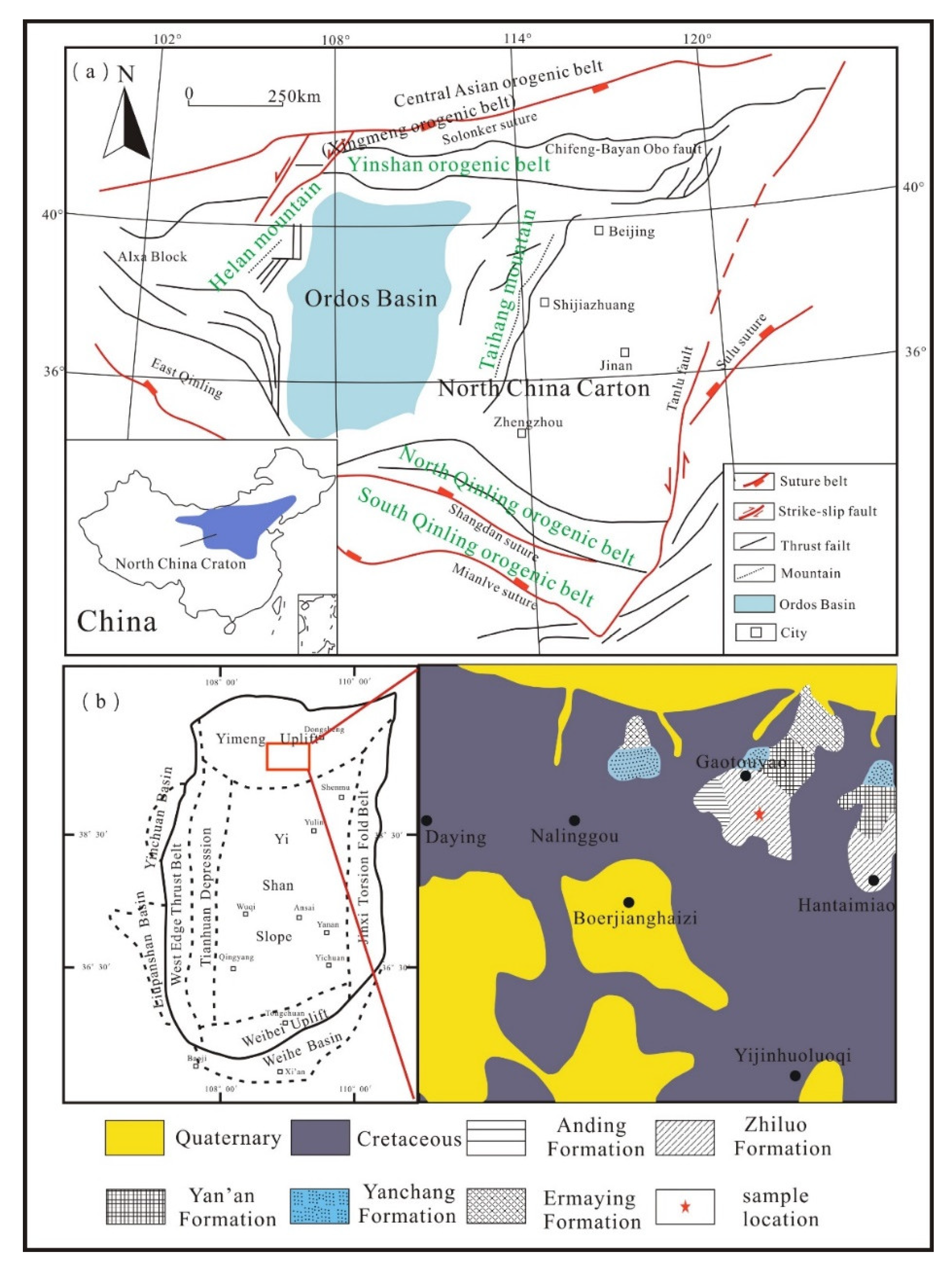

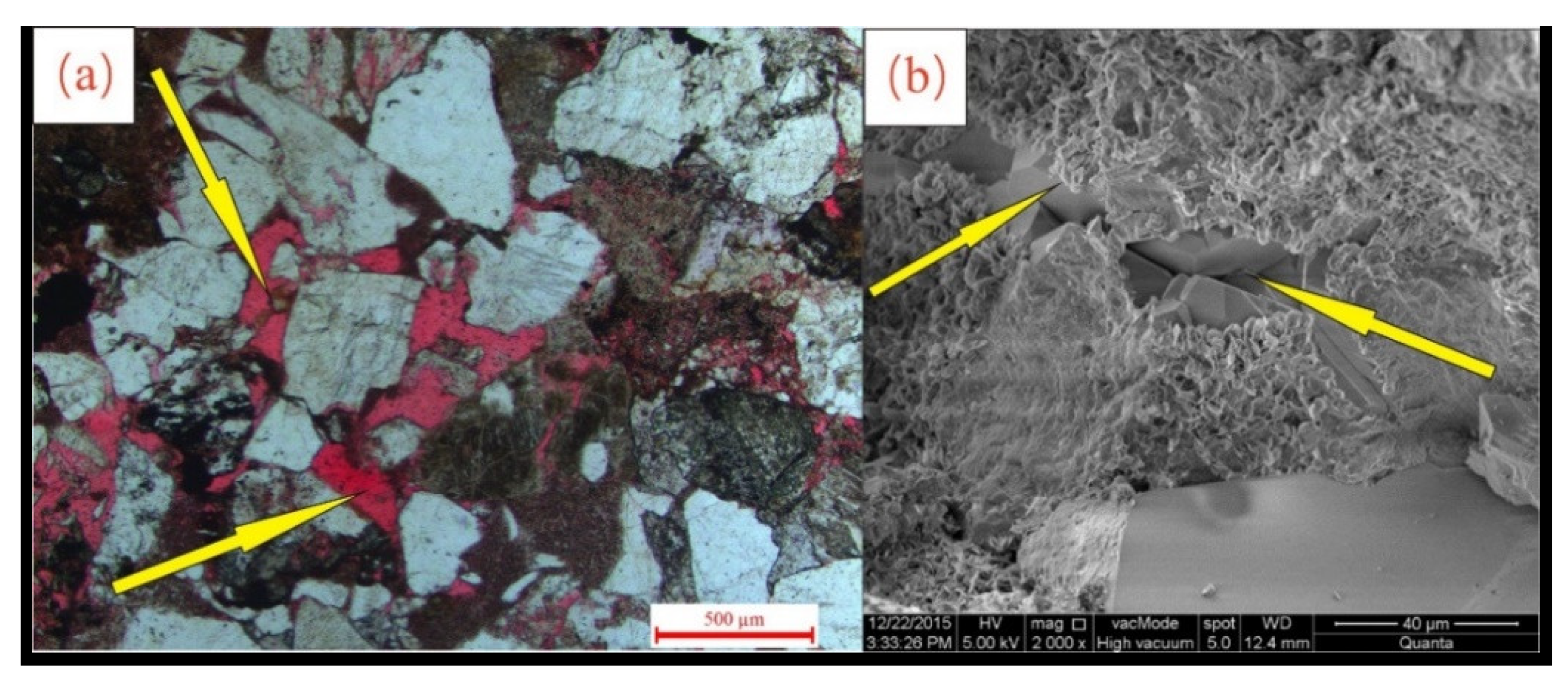




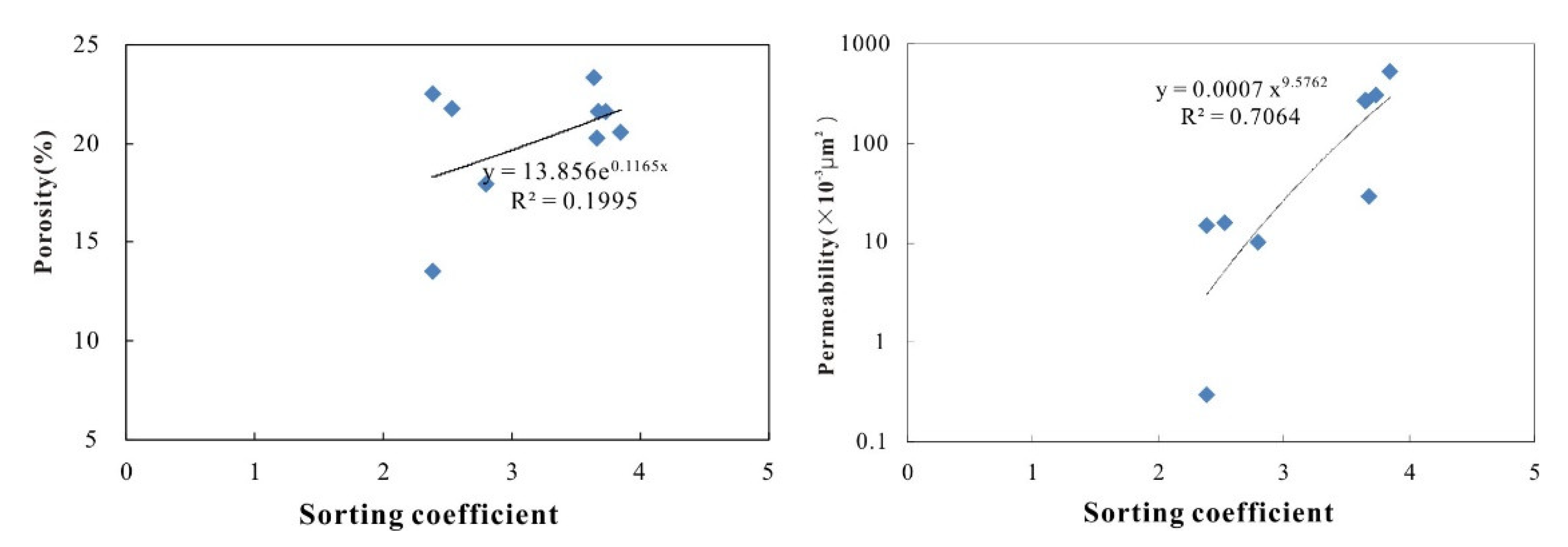

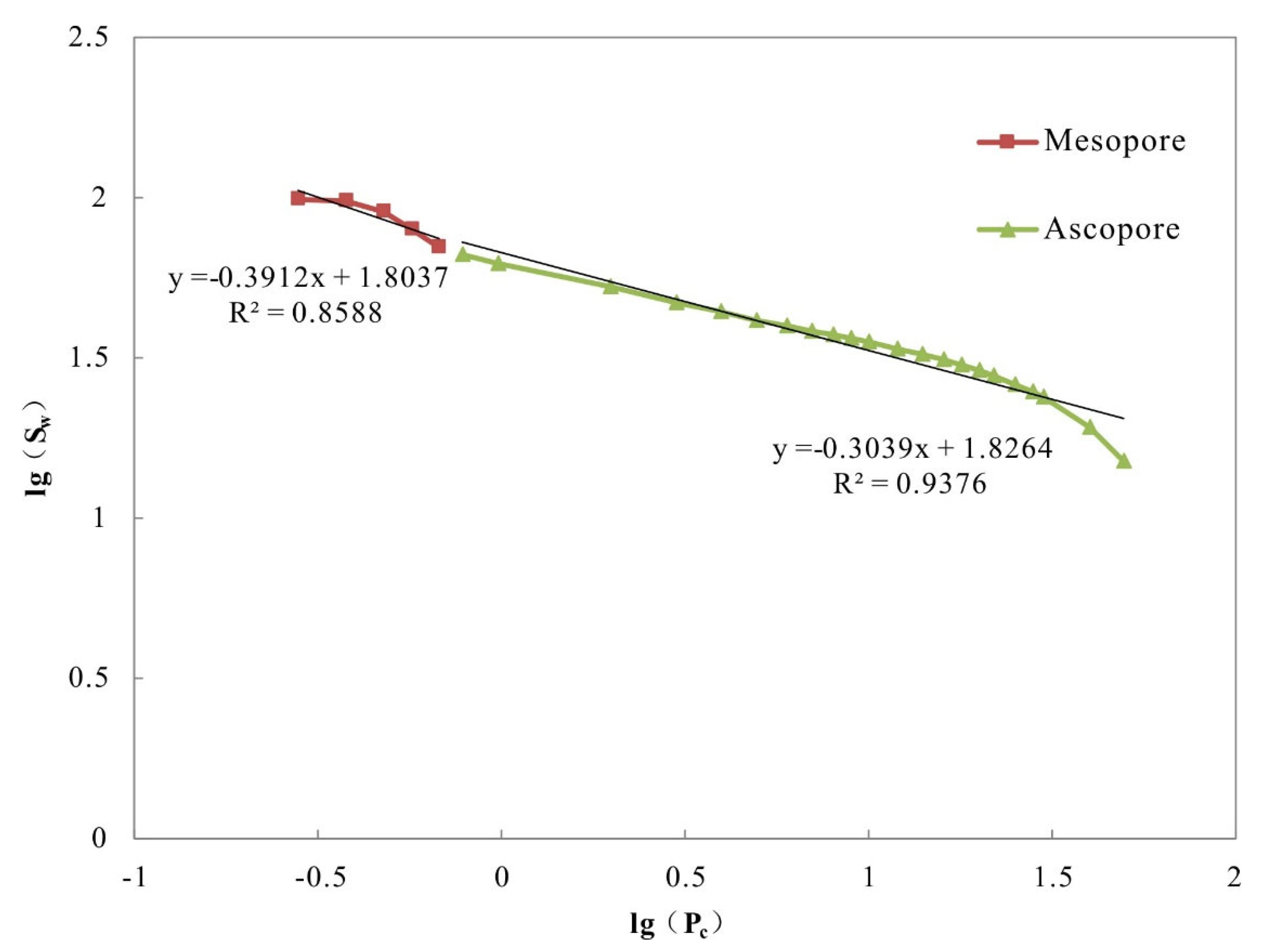
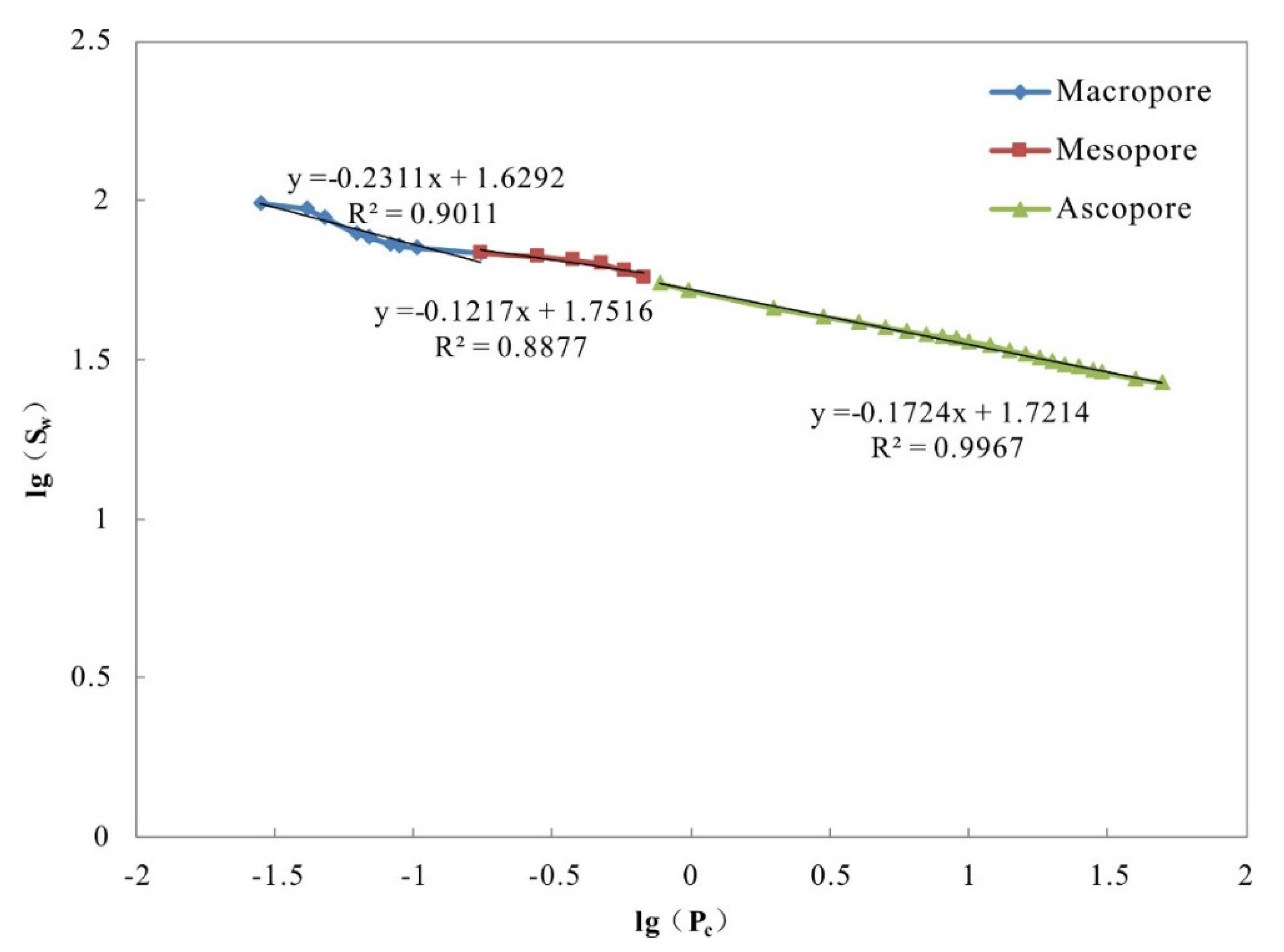
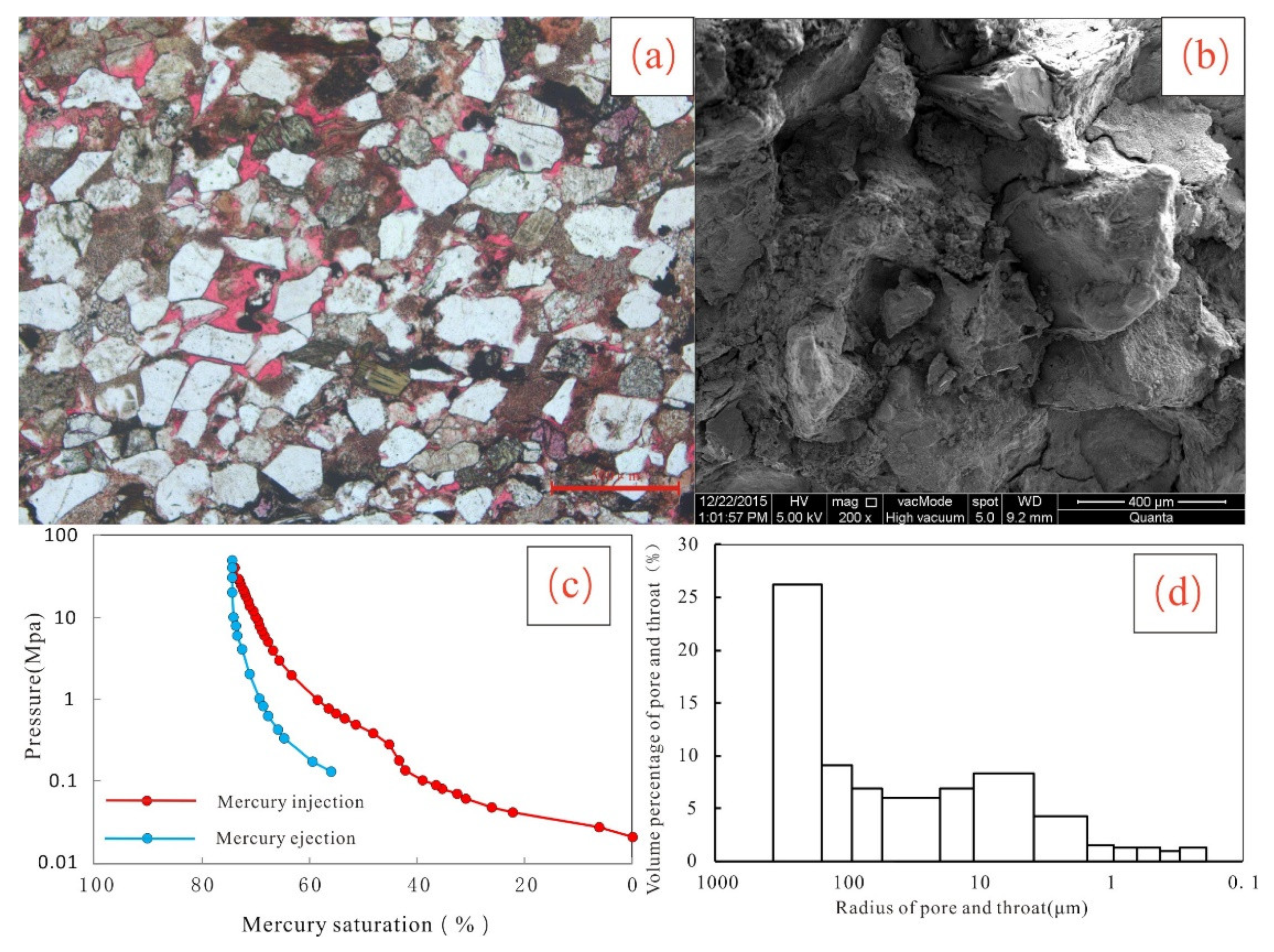
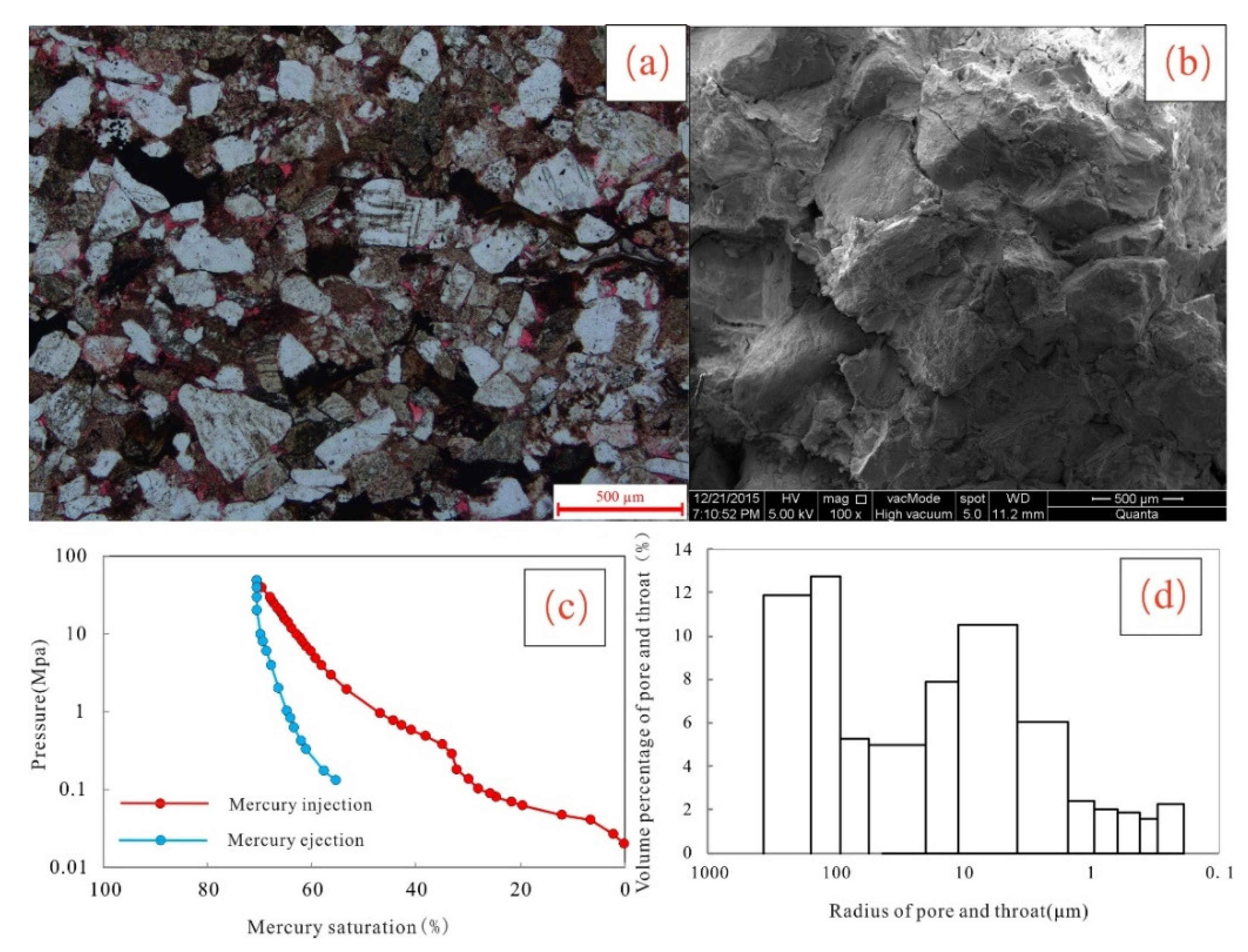



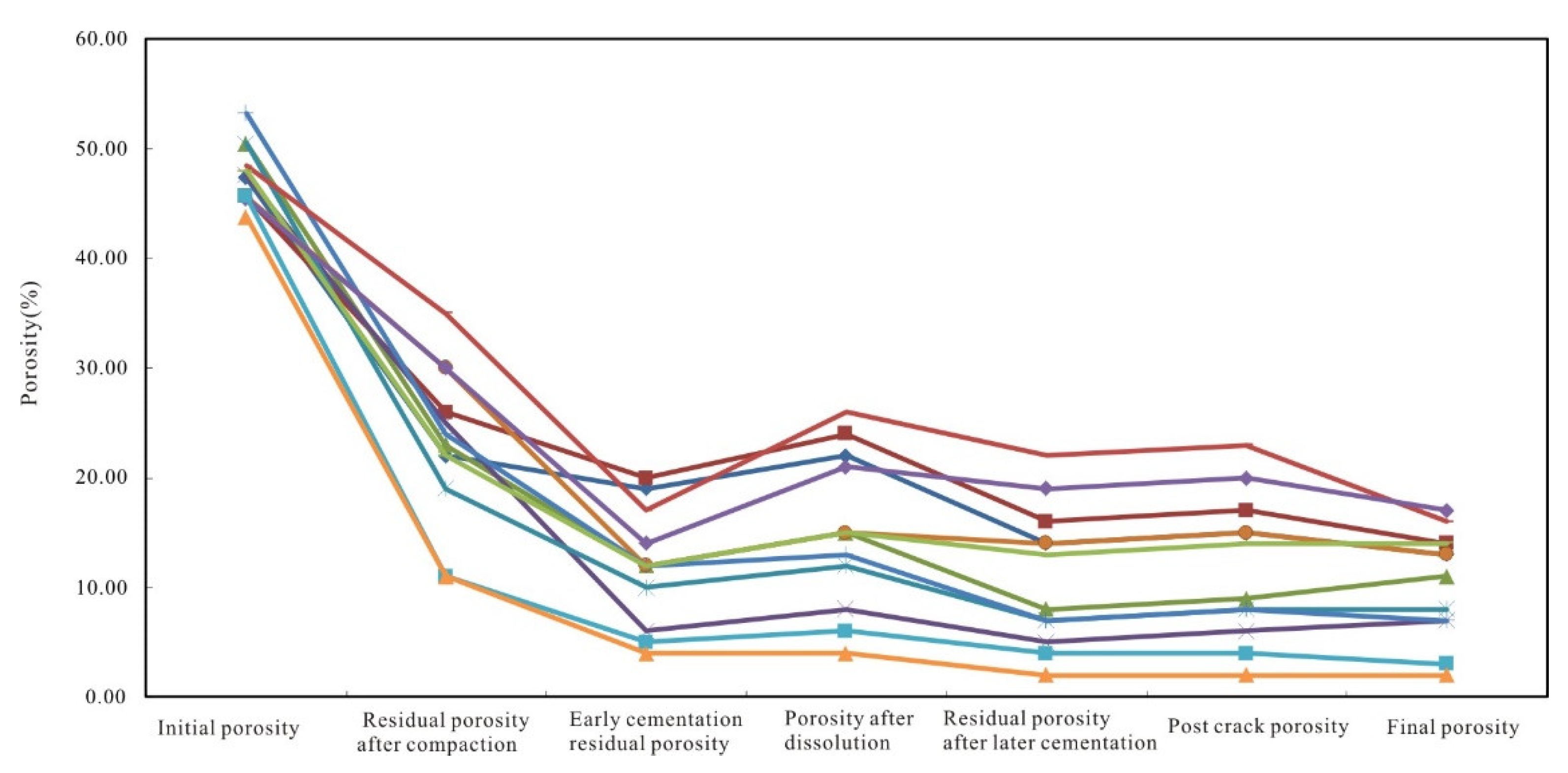
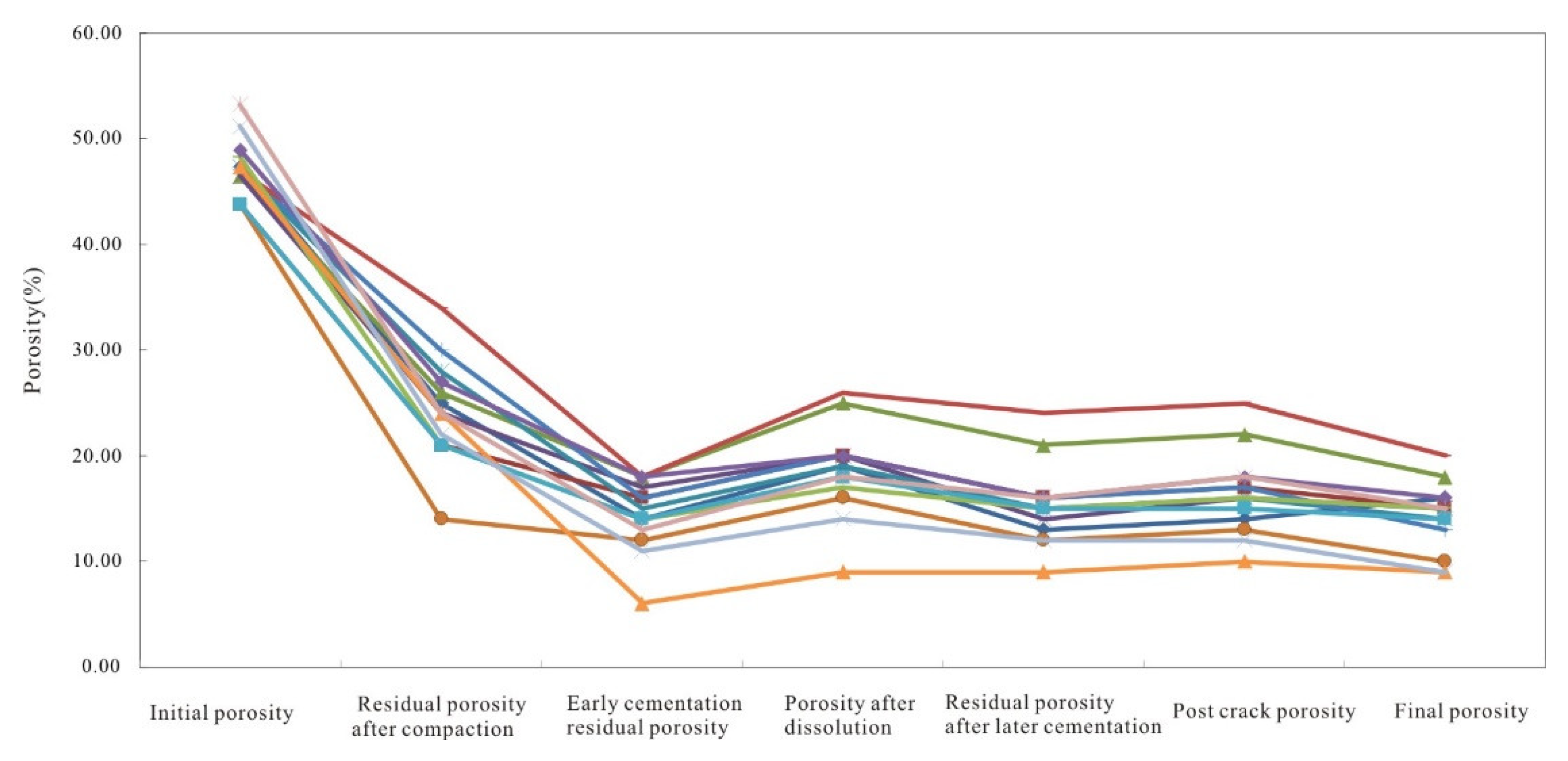

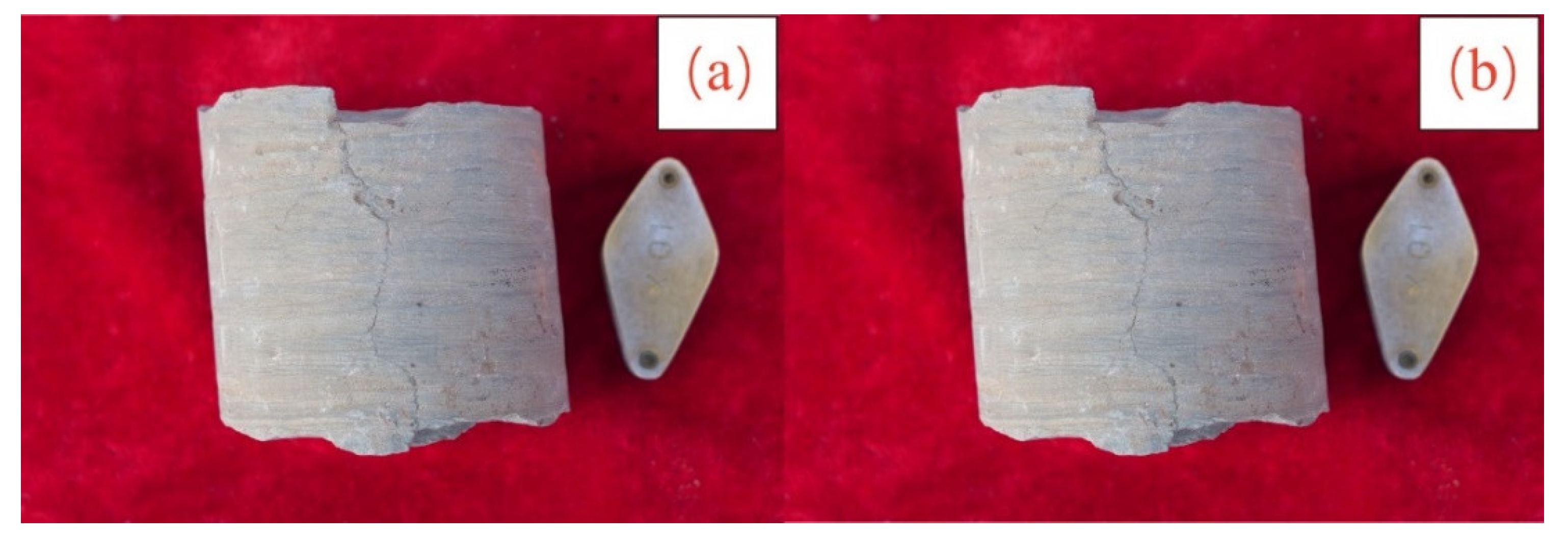
| Types | Parameter | Class I | Class II | Class III | Class IV |
|---|---|---|---|---|---|
| Macro-characteristics | Permeability (×10−3 μm) | >300 | 20~300 | 10~20 | <10 |
| Porosity (%) | >23 | 20~23 | 16~20 | <16 | |
| Permeability/porosity | >25 | 1~25 | 0.1~1 | <0.1 | |
| Type of pore and throat | Type of pore | Intergranular pores, dissolution pores, and interlayer cracks | Intergranular pores and dissolution pores | Intragranular dissolved pore | Dissolution micropores |
| Type of throat | Contracted and variable cross-section | Variable cross-section and sheet-shaped | Sheet-like and curved sheet-like | Curved sheet-shaped and bundle-like | |
| Size of pore and throat | Displacement pressure (Mpa) | <0.03 | 0.03~0.1 | 0.1~0.3 | >0.3 |
| Median pressure (Mpa) | <0.5 | 0.5~1.5 | 1.5~2.2 | >2.2 | |
| Median radius (μm) | >1 | 0.5~1 | 0.3~0.5 | <0.3 | |
| Face porosity (%) | >21 | 18~21 | 15~18 | <15 | |
| Distribution of pore and throat | Mean value | <9.5 | 9.5~10.5 | 10.5~11.5 | >11.5 |
| Skewness | <−0.4 | −0.4~−0.1 | −0.1~0.1 | >0.1 | |
| Sorting coefficient | >3.8 | 3.1~3.8 | 2.4~3.1 | <2.4 | |
| Coefficient of variation | >0.4 | 0.3~0.4 | 0.22~0.3 | <0.22 | |
| Connectivity degree | Pore–throat ratio | <0.35 | 0.35~0.36 | 0.36~0.38 | >0.38 |
| Fractal characteristics | Fractal dimension | <2.84 | 2.84~2.87 | 2.87~2.9 | >2.9 |
| Layer | Initial Porosity (%) | Residual Porosity after Compaction (%) | Compaction Loss Porosity (%) | Relative Loss Rate (%) |
|---|---|---|---|---|
| section 1 of Zhiluo Formation | ||||
| section 2 of Zhiluo Formation |
Disclaimer/Publisher’s Note: The statements, opinions and data contained in all publications are solely those of the individual author(s) and contributor(s) and not of MDPI and/or the editor(s). MDPI and/or the editor(s) disclaim responsibility for any injury to people or property resulting from any ideas, methods, instructions or products referred to in the content. |
© 2023 by the authors. Licensee MDPI, Basel, Switzerland. This article is an open access article distributed under the terms and conditions of the Creative Commons Attribution (CC BY) license (https://creativecommons.org/licenses/by/4.0/).
Share and Cite
Liu, X.; Guo, X.; Hong, Z.; Xue, X.; Li, S. Pore Structure Characteristics and Main Control Factors of Sandstone in the Jurassic Zhiluo Formation in the Northern Ordos Basin. Minerals 2023, 13, 1102. https://doi.org/10.3390/min13081102
Liu X, Guo X, Hong Z, Xue X, Li S. Pore Structure Characteristics and Main Control Factors of Sandstone in the Jurassic Zhiluo Formation in the Northern Ordos Basin. Minerals. 2023; 13(8):1102. https://doi.org/10.3390/min13081102
Chicago/Turabian StyleLiu, Xiaofeng, Xiaodan Guo, Zenglin Hong, Xuping Xue, and Shifeng Li. 2023. "Pore Structure Characteristics and Main Control Factors of Sandstone in the Jurassic Zhiluo Formation in the Northern Ordos Basin" Minerals 13, no. 8: 1102. https://doi.org/10.3390/min13081102
APA StyleLiu, X., Guo, X., Hong, Z., Xue, X., & Li, S. (2023). Pore Structure Characteristics and Main Control Factors of Sandstone in the Jurassic Zhiluo Formation in the Northern Ordos Basin. Minerals, 13(8), 1102. https://doi.org/10.3390/min13081102





